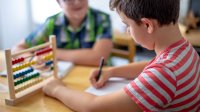How Dyslexia Can Impact an Elementary Student’s Performance in Math
Young students with dyslexia may need more story contexts to truly understand the four basic operations.
Your content has been saved!
Go to My Saved Content.When we think about language-based learning disabilities, such as dyslexia, we almost exclusively think about reading, writing, and language. Dyslexia is a neurologically based learning difference that impacts each person differently. Children with dyslexia typically have difficulty with
- decoding,
- encoding,
- accurate and/or fluent word recognition,
- phonological awareness, and
- reading comprehension.
Most likely, you have at least one student with dyslexia in your classroom. While the exact number of American children with dyslexia is currently unknown, some estimate that it may impact as many as 15–20 percent of students. This difference in neurology affects not only children’s ability to learn how to read and write but also their academic progress throughout the day.
Taking a Strengths-Based Approach
In The Dyslexic Advantage, Brock L. Eide, MD, and Fernette F. Eide, MD, emphasize that the brains of those with dyslexia are wired differently than neurotypical brains: “Their differences in wiring often lead to special strengths in processing certain kinds of information, and these strengths typically more than make up for the better-known dyslexia challenges. By learning how to reorganize, nurture, and properly use these strengths, individuals with dyslexia can be helped to achieve greater success and personal fulfillment.”
Through many math curricula, students are initially introduced to the four basic operations in a progression from concrete actions to abstract contexts. They explore the action of the operation (e.g., addition as putting together), and only at the end of the unit do students explore the actions in the real world through various contexts, typically as story problems.
Providing Important Contexts
But the contexts don’t have to be abstract. What if, as a way to strengthen students’ understanding while they are in the concrete stage, students were able to explore different contexts first as a mode of building their conceptual understanding of the action of the four operations? Think about division—can you separate 13 balloons into four equal groups? What about 13 cookies? The representation of each situation, and the quotient, depends on the context.
Children with dyslexia, especially those who are most successful when they are able to see the big picture, can do well with story contexts. Computing with numbers in isolation can be too abstract for some students. Thinking about 13÷4 is more challenging than asking a child to evenly share 13 balloons or cookies with three friends.
Providing a context better allows a child to understand the action of the operation (in this case, separating a whole into four equal groups). This can also help to increase a child’s interest in the subject matter, especially if they are given the opportunity to be a part of the contexts or create the contexts themselves.
Rote memorization of facts and concepts can be more challenging for children with dyslexia, but the contexts give them something to hold on to when learning new concepts and exploring number relationships.
Incorporating Personalized learning
Including vocabulary and comprehension may be initially challenging for students with dyslexia, but with proper scaffolding, it can aid in their understanding of both mathematical concepts and reading comprehension skills. One of these scaffolds might be to connect story contexts to a child’s everyday life—sharing cookies, for example.
In Making Meaning for Operations, the authors assert that “children derive informal mathematical knowledge from all aspects of their world. Setting the table, counting objects to compare quantities with someone else, pooling collections of items… these and other everyday experiences form the basis of the mathematical understanding children bring with them from home,” and this background knowledge can easily and effectively be utilized in the classroom.
Acting out various contexts, restating them in your own words, and creating your own contexts are all methods of supporting students’ growing understanding of the action of the operations.
Real-Life Examples
When we think about the concrete-representational-abstract model of math instruction, I would argue that many children with dyslexia need to spend more time than their neurotypical peers in the concrete stage. We know that this should involve using various manipulatives, but it also should include contexts—real-life situations that ground a student in the action of mathematics.
It also doesn’t always have to be about finding the answer! A context can focus on relationships. For example, “There are children at the town pool. Eight of them are in the pool and 12 are sitting on chairs. Then four children get into the pool. Now 12 people are in the pool, and eight people are in the chairs.” This context asks students to think about turn-around facts—how 8+12 is related to 12+8.
As an elementary school teacher, I can often fall into the trap of hyperfocusing on the deficits of a student with dyslexia rather than their strengths. In our current teaching environment, where our standardized tests do not take into account so many facets of a child’s being, it’s easy to do. But something I keep in mind is that as Brock and Fernette Eide wrote, “Even Einstein and Newton didn’t look like ‘Einstein’ and ‘Newton’ in second grade.”
Utilizing contexts in order to provide students with more concrete examples of the actions of mathematics will allow students with dyslexia to build their identities as confident, capable mathematicians, perhaps even sparking a passion for math in their future!
